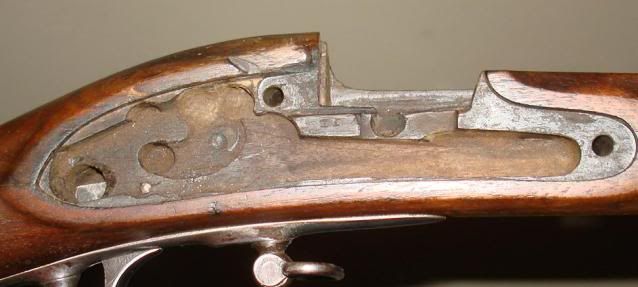Hello all...New to the forums & first post ... Ran through a few Search pages here looking for info on the 1816 muskets and appreciate the high level of expertise that can be found here... Thanks for a Great place......
I have acquired a cut down Harpers Ferry 1816 FL musket w/ 69 cal. smoothbore 30 in bbl... The lock is 1833 dated... 6 ½ inches long...the bbl tang is also 1833 dated...It has inspection initials and marks stamped in various places over the gun...and I’ve identified the block initials of Adam Rhulman AR...and James A Schaeffer JAS as seen in the photos...The man I recently purchased it from said he purchased it as is in 1954 when he was in college in Utah...He speculated it might be some kind of experimental weapon... But in all the years he had it he’d never found out anything about it saying that all of Harpers Ferry records were destroyed in the famous John Brown raid... I’ve seen net photos of other cut down 1816s with varying bbl lengths...some with the front bbl bands like this one and others modified...But all of those have been percussion converted as was the practice for the later types net research has shown...I’d appreciate the board’s input as to what you think this is... One other question... Were their ramrods threaded on the end to accept a worm or jag? I’d love to see a pic of ramrod end that goes in the wood... threaded or not... whatever the case may be...next to a tape measure even better! Looking forward to any input/info... Thanks all...










I have acquired a cut down Harpers Ferry 1816 FL musket w/ 69 cal. smoothbore 30 in bbl... The lock is 1833 dated... 6 ½ inches long...the bbl tang is also 1833 dated...It has inspection initials and marks stamped in various places over the gun...and I’ve identified the block initials of Adam Rhulman AR...and James A Schaeffer JAS as seen in the photos...The man I recently purchased it from said he purchased it as is in 1954 when he was in college in Utah...He speculated it might be some kind of experimental weapon... But in all the years he had it he’d never found out anything about it saying that all of Harpers Ferry records were destroyed in the famous John Brown raid... I’ve seen net photos of other cut down 1816s with varying bbl lengths...some with the front bbl bands like this one and others modified...But all of those have been percussion converted as was the practice for the later types net research has shown...I’d appreciate the board’s input as to what you think this is... One other question... Were their ramrods threaded on the end to accept a worm or jag? I’d love to see a pic of ramrod end that goes in the wood... threaded or not... whatever the case may be...next to a tape measure even better! Looking forward to any input/info... Thanks all...






























